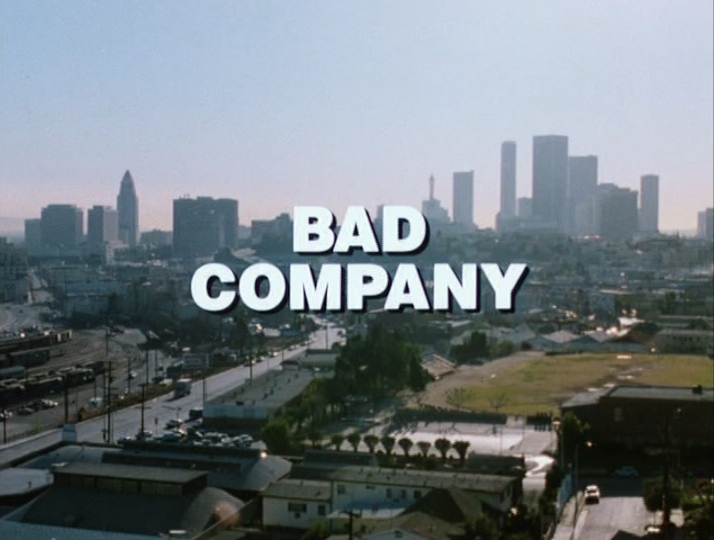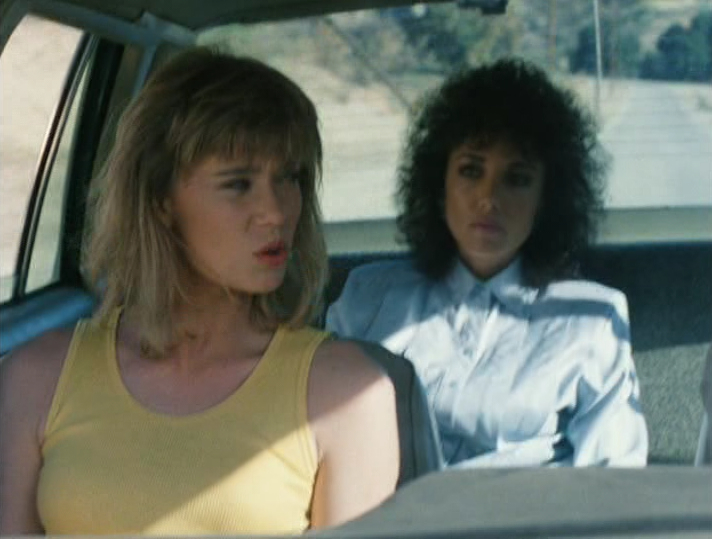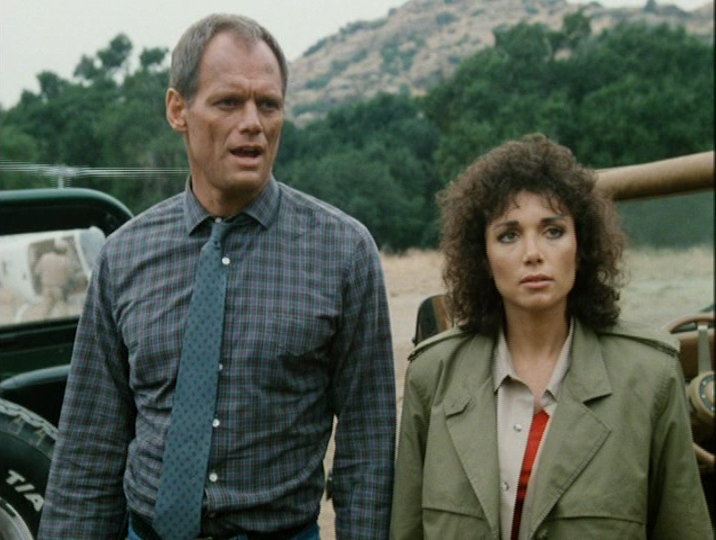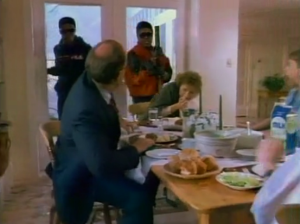This article examines U.S. public awareness of mass incarceration of Black people through the stories told on police procedural television programs. Though not quoting directly when focusing on mass incarceration and White supremacy I am informed by lectures and writings on prisons and racism by Angela Davis, George Jackson, Michelle Alexander and Mariame Kaba. Please see their works for in depth analysis of prisons and White supremacy and Kaba’s Project NIA (or related efforts across the continent) for ways to take action to end the injustice described in this essay.
_________
The punch line is a common exercise in storytelling beyond comedy. Punch lines are occasionally educational but much more often they depend on what the audience already knows. For this reason they are at least as telling of the audience as they are of the storyteller. This essay examines a particular punch line common to cop shows, with a focus on a 1987 episode of Hunter — that of the comeuppance of neo-Nazis by the police when the neo-Nazis are to be incarcerated in the U.S. prison system and thus, alongside people of color. Further, this essay also looks at what this punch line says about public awareness of and support for the mass incarceration of Black people and how normative White supremacist discourse contorts it into a purported anti-racism.
The Hunter episode “Bad Company” (Season 3, Episode 11 – 10 January 1987) begins with a group of white men and women robbing a Los Angeles gun store and killing the store owner. Police arrive in short order and a shoot-out between the cops and robbers ensues. Two of the robbers are injured, one killed and the other slightly wounded. The wounded party is Angela (Lar Park-Lincoln) who is transferred into the custody of Detective Sergeants McCall (Stepfanie Kramer) and Hunter (Fred Dryer) upon release from the hospital. We soon find out Angela is the daughter of Brother Hobarts (Dean Stockwell), the head of the National Aryan Order, a White nationalist militia on the outskirts of Los Angeles.
Hunter and McCall transport Angela to another location. En route they engage her on her ideology, telling her she is off base as they attempt to turn her snitch. She replies, accurately but against normative liberal White supremacist discourse, that White nationalism is “what America is all about.” She continues while elucidating a fairly mainstream – if a little cartoonish so as to indicate viewers shouldn’t identify with with Angela too strongly – racist narrative “The right of decent Americans to defend their way of life against freeloaders and subversives and the mud races. I mean it’s nothing personal guys, but you’re on the wrong side.”
Angela explains to McCall and Hunter why her version of White supremacy is better than theirs..
Hunter and McCall are captured by the National Aryan Order during the trip when the group rescues Angela from police custody. Up to this point Angela is still loyal to the Aryan National Order. McCall and Hunter do not manage to recruit her until one group member murders her love interest (who is also a neo-Nazi). Now betrayed, albeit not ideologically, Angela helps the cops escape and the group is eventually joined by other police who proceed to stop Brother Hobarts and crew from carrying out a planned attack. Hunter confronts Brother Hobarts, who is by this time in bracelets, and delivers the punchline “you Brother Hobarts are going to prison. Half the men you meet there belong to those mud races you were talking about. They’re gonna like you.”
Hunter gives Brother Hobarts his comeuppance by using racism to fight racism. Wait, what?
This is a somewhat common punch line in cop shows. The Law & Order episode “Prejudice” (Season 12, Episode 10 – 12 December 2001) ends with the incarceration of a racist white man. As the prosecutors prepare leave the office at the episode’s end, District Attorney Nora Lewin (Diane West) says, “Wonder if Burroughs will still have a problem with minorities when he gets to prison and finds out he is one.” In the CSIepisode “World’s End” (Season 10, Episode 19 – 22 April 2010), Nick Stokes (George Eads) says to a white supremacist suspect he is interrogating, “But you know what, I’m gonna do you a favor, since you like to whoop so much ass. I’m gonna have the warden put you in with some African-Americans, so they can give you an up close and personal lesson on race relations.” There are several other examples.
The Racial Caste System As Anti-Racism
These punch lines mean to show the police and the mass incarceration of Black and other people of color as possible tools against racism rather than as baselines of systemic White supremacy. These punch lines are only given meaning by an audience who will understand them as the comeuppance of racists rather than as an affirmation of the racist order of things. For this to work without souring an audience that largely believes it isn’t racist or, at least, not about prisons and crime, Black criminality must be understood as a matter of fact rather than as a matter of racial caste formation. Or, in other words, Black folk must be understood as criminals rather than mass incarceration being understood as the criminalization of Black people. Were it the other way around the shows would be (probably) canceled as the audience would (probably) receive the punch line as cruel cynicism rather than anti-racist comeuppance. (I use “probably” because with White supremacy you never know.)
For example the pilot episode of 21 Jump Street aired four months after the Hunterepisode discussed above. It’s opening scene features a wealthy white family of four seated around the dining room table for a meal when two young Black men with shotguns break through the glass of the patio doors and lay siege to the family. This introductory scene of one of the most successful cops shows is anchored with Black criminality. The 21 Jump Street pilot offered nothing novel but affirmed what was already common knowledge; that Black people were dangerous criminals. The logical consequence is that prisons must be full of such criminals.
21 Jump Street kickstarts its franchise with Black criminality
The crudest neo-Nazi articulations fall far enough outside of White supremacist normativity for the mainstream public, especially though not quite exclusively the mainstream white public, to reject them. So long as mass incarceration of Black and other people of color is not understood as a racial caste system the public can comfortably agree with a punchline which suggests that Black criminality is desserts for incarcerated neo-Nazis.
An Inversion Version
What this essay describes is one example of White supremacy’s incredible discursive flexibility.The Hunter, Law & Order and CSI episodes described above contribute to normative discourse a perfect inversion of the racial caste system. Mass incarceration of people of color is a baseline of White supremacy. Yet the punch line to these stories is one where said systemic baseline is re-imagined as an anti-racist tool against individual white supremacists while the enforcers of the baseline (the police and prosecutors) relish in their enlightened anti-racism to a produce a feel good moment for the audience. The contortion is horrifyingly impressive.
These punch lines demonstrate another thing. This essay focused on the Hunterepisode for a reason; it aired in 1987. United States liberals – largely unfamiliar with the radical Black tradition that produced critical prison analysis decades ago – are ‘discovering’ mass incarceration as a phenomenon of a racial caste system since the 2010 publication of Michelle Alexander’s tome The New Jim Crow. But the Hunteraudience over two decades before that book had to understand that the United States fills its jails in a wildly disproportionate manner with Black folks, otherwise the punch line doesn’t work.
Point being, White America knows and been knowing, it’s just not considered a problem. Mass consciousness is not critical consciousness when embedded in normative oppression. That the broad contours of an oppressive system are common knowledge might, however, offer opportunities for organizing. The same knowledge in a framework rejecting Black criminality, mass incarceration and White supremacy produces a very different discourse. To assist with efforts to produce a liberatory discourse please visit the “Resources” page on the Project NIA website.
_____
This piece originally appeared on Jimmy Johnsons’s blog.





If prison is seen as a racial caste system in which many black people are unjustly imprisoned, then putting violent white supremacists in prison isn’t justice. It’s further punishment for, and danger to, black people. You’re locking them up with dangerous fascists who want to kill them.
Agree 100%. But in the episodes it’s portrayed as ‘justice’ because of the underlying assumption of Black criminality.
This is a great post! Would love to see more analysis of cop shows!
Curious about how you did he research for this. Are you just really familiar with these shows (I haven’t thought of Hunter for years!) or did you have some good resource aside from Google for searching through TV episodes plots/narrative elements?
It’s something I’ve been studying but have only just begun to write on. Am putting together a database of sorts as I collect data from each show (numbers of police shootings, who is killed, are Black ppl portrayed as gang members and Mexican ppl narcotraffickers, are rapes portrayed as ‘he said she said’, etc.). After it gets enough data to be useful I’ll find a way to make it publicly available so others can use it for their own works.
Are you an academic Jimmy? I’m just realizing I don’t know anything about you!
Nope, just an organizer who watches too much tv!
Hah; well, if you want to post your data here, I’d love that.
I wonder if there is a relationship between these 80s cop shows that had no problem representing/reinforcing black criminality and 80s comics that often used difference _within_ white identity (like punks) to stand in for the kind of urban crime and blight that people associate with blackness in the real world.
I wrote some about that here: https://themiddlespaces.wordpress.com/2014/09/24/super-hegemonic-team-up/
But also wrote about it in terms of Robocop: https://themiddlespaces.wordpress.com/2015/01/13/robocop-and-white-washing-of-detroit/
Hey that would be great! Thanks!
Did you read “The Position of the Unthought”? It’s a conversation between Saidiya Hartman and Frank Wilderson that gets into white stand-ins and how sympathetic identification results in the same obliteration, “Only if I can see myself in that position can I understand the crisis of that position.” And how in such situations, “white bodies become proxies for real enslaved black bodies and […] the actual object of identification, the slave, disappears.” Really amazing, like everything they do!
Seems like there might be problems even for the more clueless white authors of seeing cartoonish portrayals of Black people as actual cartoons (though that hasn’t stopped Bendis and how he writes Black people for Powers…). Whereas in tv and film white writers could see their racist images given life by actual Black people. Dunno if that’s a real thing though. Could just be something I hope to be true! But intended audiences of the time of white juveniles vs white adults in the two genres probably plays a big role.
That’s interesting; I haven’t seen that conversation. Seems like it gets at some of the problems with the X-Men, or with sci-fi imperial reversals like War of the Worlds.
Article looks like it’s paywalled unfortunately: http://www.jstor.org/stable/20686156?seq=1#page_scan_tab_contents
Check your email, Noah.
Thanks for that reference, Jimmy! It is the kind of thing I would never have found otherwise, but that will be very useful in my work!
Noah thinking about your first comment again and not sure I understood it right. I left out entirely from the analysis the parallel to Black criminality, the end of white criminality. Not only is it assumed that prisons are full of Black people, but that said Black people will prey on white people instead of – as you point out – the inverse. It’s another aspect of the criminalization of Blackness where even neo-Nazis are to be victims of Black criminals.
Yep. they seem to do better with that in Oz…or at least, in the first episode, the neo-Nazi guy seems incredibly evil and awful and certainly as much of a threat to others as they are to him.
they do a nice bit where one white guy thinks the neo-Nazi will protect him at first because of his own fears of black criminality/assumption that white people aren’t criminals. That works out poorly for him.
Pingback: The Anti-Black Geography of Revitalizing Detroit | CiCo3